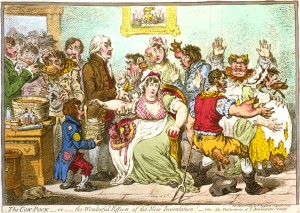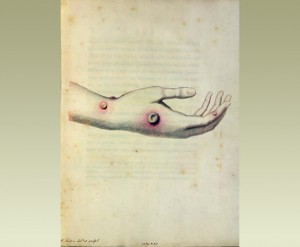By Juliet Wagner (Regular Contributor)
“The deviation of Man from the state in which he was originally placed by Nature seems to have proved to him a prolific source of Diseases. From the love of splendour, from the indulgences of luxury, and from his fondness for amusement, he has familiarised himself with a great number of animals, which may not originally have been his associates.
The Wolf, disarmed of his ferocity, is now pillowed in the lady’s lap. The Cat, the little Tyger of our island, whose natural home is the forest, is equally domesticated and caressed. The Cow, the Hog, the Sheep and the Horse, are all, for a variety of purposes, brought under his care and dominion.”
Edward Jenner, “A Inquiry into the Causes and Effects of the Variolae Vaccinae” (1798)
This might appear an unusual introduction to a scientific paper, but Edward Jenner’s lyrical description of Man’s domestication of animals was written in anticipation of the horror he knew his innovation would evoke. His “vaccine” against smallpox, proposed in 1798, was so-called because it involved infecting humans with cowpox in order to protect them against the much more dangerous human disease: vacca is the latin word for cow.
Jenner’s vaccine proved highly effective, and is considered to have saved countless lives in the course of the nineteenth century, when its introduction consistently reduced the smallpox mortality rate by 90% (the introduction of compulsory vaccination cut smallpox deaths by another third, on average). Yet Jenner was sufficiently anxious about the reception of his technique that he chose to publish his results himself, rather than submit them to the Royal Academy of Science. He knew that infecting humans with an animal disease would prove especially controversial. In fact, rather than directly infect a human for his experiments, he used the pus from the sore a milkmaid who had already contracted cowpox naturally, Sarah Nelmes. The boy he vaccinated with this matter later had almost no reaction to inoculation with smallpox, indicating that the cowpox vaccine had indeed conferred immunity. Inoculation (deliberately giving a healthy individual a mild case of smallpox to generate immunity) was already widespread by the late 18th century, but it carried the risk of potentially spreading smallpox, which is why Jenner’s cowpox method was so lauded.
Resistance
The vaccine did not meet with universal acclaim, however, and as Jenner anticipated, the association with animals was the cause of particular disdain and disapproval. James Gilray’s caricature “The Cow Pock, or the Wonderful Effects of the New Inoculation!” (1802) mocks this reaction, showing recipients of the vaccine developing bovine features and sprouting miniature cow heads.
 The “unnatural” mingling of human and beast continued to distress anti-vaccinators a century later:
The “unnatural” mingling of human and beast continued to distress anti-vaccinators a century later:
“Vaccination is a loathsome disease of uncertain origin, artificially transmitted, through various beasts and capable of setting up a variety of repulsive, dangerous, and even fatal affections.” (The Vaccination Enquirer, 1914)
While Charles Dickens was a prominent advocate of compulsory vaccination, George Bernard Shaw described it as “a particularly filthy piece of witchcraft.”
State of Nature
Jenner’s opening passage is intriguing, because it alludes to both the hypothetical “state of nature” of natural rights theory and to the Fall of Man in Genesis. Through his dominion over animals, Jenner explains, Man is responsible for their “degeneration” and for diseases that result from domestication. Female sensuality and concupiscence is especially to blame: it is in the “lady’s lap” where the wolf has been “disarmed,” as Eve’s congress with the serpent led to the expulsion of Man from Eden.
Writing for a largely Christian audience whose hesitation towards vaccination was motivated by faith too, Jenner cleverly employed these biblical allusions in order to place the use of cowpox to treat humans within the norms of the modern –albeit fallen – world.
For Jenner’s full text, see Edward Jenner, “A Inquiry into the Causes and Effects of the Variolae Vaccinae” (1798)
On the history of smallpox, see Ian and Jennifer Glynn, The Life and Death of Smallpox (New York: Cambridge University Press, 2004)

